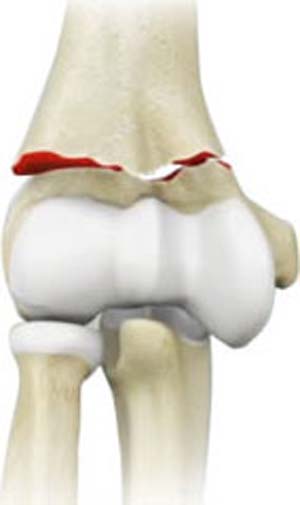Elbow Fractures

The elbow is a joint that consists of three bones - the humerus (upper arm bone), radius (forearm bone) and ulna (forearm bone). An elbow fracture most commonly occurs when your child falls on an outstretched arm. It can lead to severe pain in the elbow and numbness in the hand. Fractures are more common in children due to their physical activities as well as their bone properties. Children's bones have an area of developing cartilage tissue called a growth plate which is present at the end of long bones that will eventually develop into solid bone as the child grows.
How are Elbow Fractures in Children Evaluated?
Your child's doctor first evaluates your child's arm for signs of damage to blood vessels and nerves. An X-ray examination is then ordered to confirm and determine the severity of the fracture. Treatment of elbow fractures depends on the degree of displacement and type of fracture:
- Non-surgical treatment: If there is little or no displacement from the normal position, non-surgical treatment is recommended. Your child's doctor may immobilize the arm using a cast for 3 to 5 weeks. Regular X-rays are ordered to check if the bones are properly aligned.
- Surgical treatment: Surgery may be recommended if the fracture has caused the bones to move out of alignment. Your child's doctor brings the bones in correct alignment and may use metal pins, screws and wires to hold the bones in place. Your child must wear a cast for a few weeks. Exercises to improve the range of motion will be instructed after a month of healing.
What are Elbow Fractures?
Three bones, the humerus, radius and ulna, make up the elbow joint. Elbow fractures may occur from trauma, resulting from various reasons; a fall on an outstretched arm, a direct blow to the elbow, or an abnormal twist to the joint beyond its functional limit.
What are the types of Elbow Fractures?
The types of elbow fractures include:
- Radial head and neck fractures : Fractures in the head portion of the radius bone are referred to as radial head and neck fractures.
- Olecranon fractures : These are the most common elbow fractures, occurring at the bony prominence of the ulna.
- Distal humerus fractures : These fractures are common in children and elderly people. Nerves and arteries in the joint may sometimes be injured in these fractures.
Symptoms of Elbow Fractures
Symptoms of an elbow fracture include pain, bruising, stiffness, swelling in and around the elbow, a popping or cracking sound, numbness or weakness in the arm, wrist and hand, and deformity of the elbow bones.
Diagnosis of Elbow Fractures
To diagnose an elbow fracture, X-rays of the joint are taken. In some cases, a CT scan may be needed to view the details of the joint surface.
Treatment Options for Elbow Fractures
The aim of treatment is to maximize early motion and to reduce the risk of stiffness. Non-surgical treatment options include pain medication, ice application, the use of a splint or a sling to immobilize the elbow during the healing process and physical therapy. Surgery is indicated in displaced and open fractures to realign the bones and stabilize the joint with screws, plates, pins and wires. Strengthening exercises are recommended to improve the range of motion.
